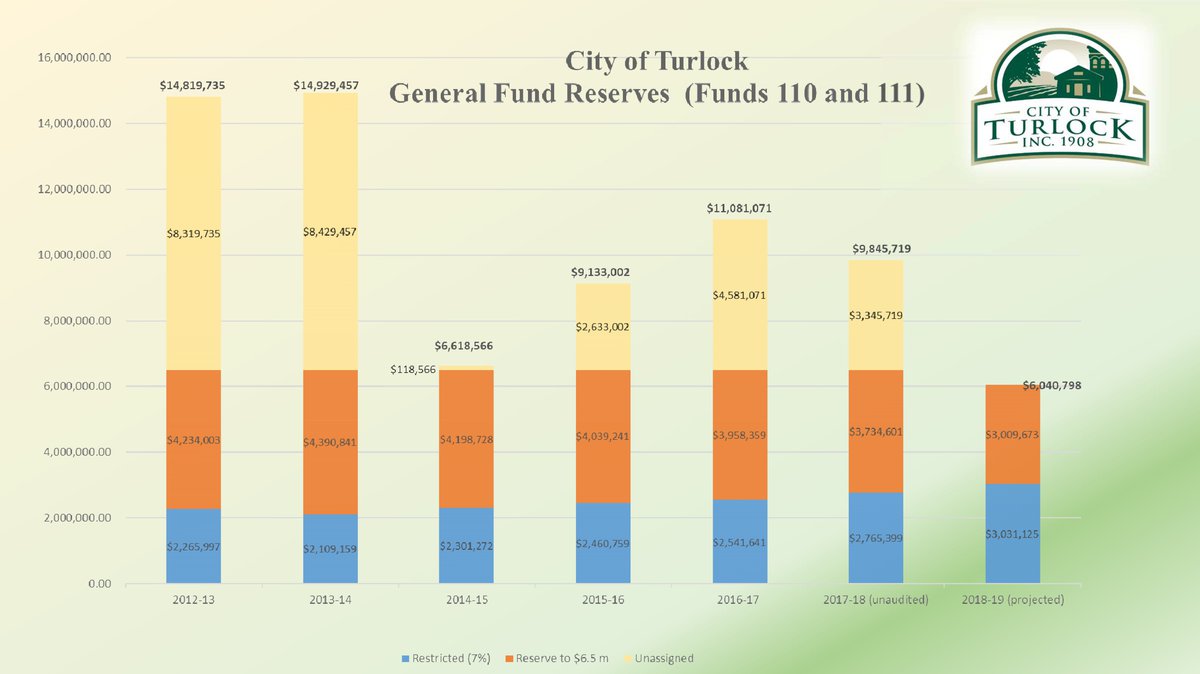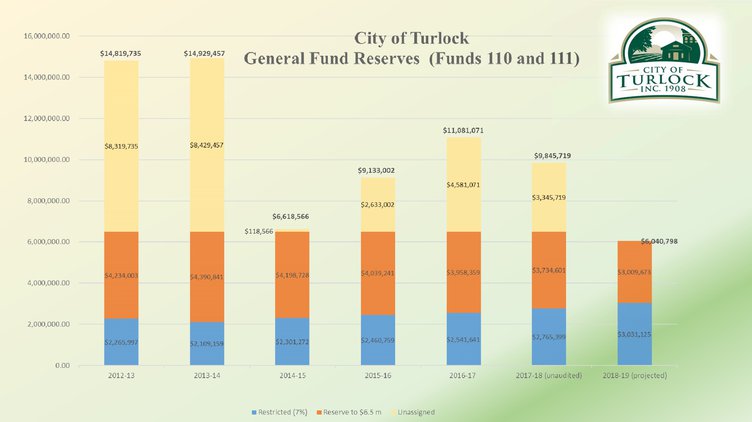The Turlock City Council recently took steps to decrease the current city budget deficit — projected in mid-March to reach $3.9 million — as well as looked at potential sources of revenue, including a new tax.
The facts paint a bleak financial picture for the City of Turlock. The City was projected in mid-March to end the 2018-19 fiscal year in June with a $3.9 million deficit. This deficit would see General Fund Reserves drop to just over $6 million (compared to $9.8 million in 2017-18 and $11.08 million in 2016-17). If the City continues in its current deficit spending pattern, the General Fund Reserves will be below $3 million by June 2020. The Turlock Municipal Code mandates that the City maintain at least a 7 percent reserve ($3.027 million). To change the code, the Council would have to hold a public hearing and it would require a 4/5ths vote.
To help staunch the flow of red ink, the City Council asked each department to come up with cuts in their respective budgets that could be enacted immediately. The cuts were presented to the City Council at their March 26 regular meeting.
The City departments combined presented the Council with $407,263 in cuts for the remainder of the 2018-19 fiscal year. The majority of the budget savings came from freezing hiring of open positions and eliminating employee training.
Other cuts included eliminating travel expenses for the Mayor, City Council members and City Manager ($9,822); suspending purchases of safety equipment for the police department ($10,000); cutting nuisance abatement supplies that help with graffiti ($10,000); and cutting promotional supplies for Parks and Recreation ($5,000).
While the Council appreciated the work the department heads did to come up with the cuts in their respective budgets, it wasn’t enough.
“I’m not thrilled with the $407,000 number. I guess I was expecting more…I feel like it needed to be a little more substantial. I know you guys are trying, you’re doing your best and I get that. But it seems to me like we’ve got to put everything on the table right now so that maybe we can figure ourselves out of the hole because next year it’s just going to get worse,” said Council member Rebecca Arellano, the newly appointed representative of District 4.
Following Arellano’s comments, the City Council voted to approve the budget amendments presented to them that night, but also requested the department directors come up with an additional $200,000 in cuts by their next meeting on April 9.
After seeking ways to make a dent in the City’s deficit through cuts, the City Council heard a presentation from Finance Director Kellie Jacobs-Hunter on revenue generating options.
After educating the Council and public on the difference between fees and taxes and the fact that it’s against the law for a municipality to charge a fee that exceeds the reasonable cost providing a service or regulating a business, Jacobs-Hunter overviewed types of taxes local voters could approve.
The first to be discussed was a Sales and Use Tax. Turlock’s current sales tax is 7.875 percent and includes 7.25 percent statewide base, ½ percent transportation .50 percent (Measure L), and 1/8 cent for Libraries (.125 percent). Jacobs-Hunter estimated that a 1/8 cent tax would generate $1.8 million a year; ¼ cent tax $3.6 million a year, ½ cent tax $7 million, ¾ cent tax $10 million and 1 cent tax would mean $14 million a year in added revenue.
Next, the Council looked at a Business License Tax. City of Turlock’s current Business License Tax was approved by voters in 1996. It was approved with a maximum annual amount “cap” to be paid and an inflationary adjustment to the cap. Any increase, extension, or removal the current “cap” (max annual tax paid) –excluding inflationary adjustments would need to be approved by voters. Revenue generated from current Business License Tax in 2017-18 totaled $1.3 million which 45 percent was allocated to Public Safety.
Turlock’s Transient Occupancy Tax (or hotel tax) could also be raised, with voter approval. City of Turlock’s current TOT rate is 9 percent and generated $1.6 million in revenue during fiscal year 2017-18. Increasing the TOT rate by 1 percent could approximately generate $178,000 in revenue.
The Council was also presented information on a Utility User Tax, which could be imposed on electricity, gas, water, sewer, telephone (including mobile phone and long distance), sanitation and cable television. Amount of revenue generated would depend on which utility service is taxed and the tax rate percentage. Locally, the Cities of Modesto and Ceres both have UUTs. The rate is 3 percent in Ceres and the rate varies from 3 to 6 percent in Modesto depending on the type of utility. Modesto generates approximately $21 million per year from their UUTs. If Turlock voters approved UUTs similar to Modesto’s, the revenue generated would be approximately $6.9 million a year.
The last two taxes presented by Jacobs-Hunter were a Parcel Tax and Property Transfer Tax.
A Parcel Tax is considered a special tax and requires a two-third voter approval. It is based on a parcel, or unit of real property, and generally based on a flat per-parcel rate. If Turlock voters approved a $100 parcel tax, it could generate $2.03 million in revenue a year.
The Property Transfer Tax is a tax imposed on the transfer of property. Cities can impose an additional tax at up to one half of their respective county’s tax rate. Stanislaus County’s rate is 55 cents per $500 of property value.
If the Council chose to move forward with getting a tax on the November 2020 ballot for voters to consider, they would need to start soon on polling the community for interest and developing a strategy. Putting a measure on the ballot would also be a cost the City.
The Council also heard about two revenue generating ideas that would not involve voter approval.
The City of Turlock could create additional Community Facilities Districts (under the Mello-Roos Act) to pay for street maintenance and public safety services. This imposes an annual special tax levy on new residential units within the CFD No. 2 boundaries to mitigate the gap between revenue produced and the cost of services provided to the new residential units. The 2017-18 assessment year rate was $649/single family unit (lessor for multifamily unit). All new housing subdivisions are in a CFD and pay the extra tax. The City Council could decide to put older areas of town under a CFD also.
A revenue generating idea that the City has been as of yet hesitant about — cannabis sales — was once again under discussion.
The Turlock City Council made it clear in January 2017 that there would be no marijuana dispensaries in town when they voted to prohibit all commercial activities related to cannabis, including cultivation and cannabis deliveries within the city. In January 2018, the Council also adopted a policy to deny approval to any cannabis-related enterprise within Turlock’s sphere of influence in the county.
Jacobs-Hunter told that Council that the City wouldn’t necessarily need a voter-approved cannabis tax, but could decide to implement development agreements related to cannabis operations. She said a neighboring Stanislaus County city has several development agreements currently in place and expects to receive approximately $2.2 million in revenue for 2018-19 from the agreements.
Jacobs-Hunter cautioned the City Council, however, on moving forward with any cannabis agreements.
“If you do look at this, we should only consider this a one-time revenue, meaning that if you put some agreements in place — okay, for ’19-20, this is how much we’re going to get for these development agreements, don’t count that in ’20-21 the laws in California are going to be the same,” said Jacobs-Hunter.
The Council is expected to revisit revenue generating ideas in the upcoming months when they begin discussions on the 2019-20 budget.
“I want my colleagues, employees, collective bargaining units and the public to be on the same page before we move forward. That’s the only way we can address our strategies and budget challenges,” said Mayor Amy Bublak.
Bublak said that she is constantly working on revenue generating ideas for Turlock. She thinks that economic development is key to helping Turlock succeed in the future. Bublak was recently in Sacramento advocating for the needs of Turlock and is hopeful that the Governor will put more focus on the Valley.





